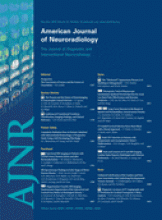Abstract
BACKGROUND AND PURPOSE: DIBSGs have the worst prognosis among pediatric brain tumors with no improvement of outcome for several decades. In this study, we determined whether diffusion imaging could improve patient stratification and our understanding of the impact of therapies.
MATERIALS AND METHODS: Nine baseline and 24 follow-up DTI studies performed in 9 patients on a 1.5T clinical MR imaging scanner were reviewed. ADC and FA were measured for the whole lesion and at 5 anatomic levels: the rostral medulla, caudal pons, midpons, rostral pons, and caudal midbrain. Reference data were obtained from 8 controls with normal brain stem, 6 patients with medulloblastoma, and 7 patients with pilocytic astrocytoma.
RESULTS: ADC was higher in untreated DIBSG than in normal brain stem and medulloblastoma (1.14 ± 0.18 [×10−3 mm2/s] versus 0.75 ± 0.06 and 0.56 ± 0.05, both P < .001). FA was lower in DIBSG than in normal brain stem (0.24 ± 0.04 versus 0.43 ± 0.02, P < .001) but was higher than that in pilocytic astrocytoma (0.17 ± 0.05, P < .05). Lower baseline ADC and higher FA correlated with a worse clinical course. Correlations were more significant at the caudal midbrain than in other regions. ADC decreased and FA increased after RT. Changes of FA after RT at the caudal midbrain correlated with event-free survival.
CONCLUSIONS: Baseline ADC and FA of DIBSG revealed hypocellular tumors with extensive edema. Diffusion changes after therapy implied reduced edema but did not support a significant response to therapy. The significance of diffusion properties varied with anatomic locations, the caudal midbrain being particularly important.
Abbreviations
- ADC
- apparent diffusion coefficient
- ADCCM
- ADC at the caudal midbrain
- ADCLesion
- mean ADC of whole lesion calculated from the 5 anatomic regions examined
- ADCmax
- largest ADC value measured in the 5 anatomic regions examined
- ADCmin
- lowest ADC value measured in the 5 anatomic regions examined
- ADCMP
- ADC at the mid pons
- ADCRP
- ADC at the rostral pons
- AVA
- Avastin (bevacizumab)
- Bsl
- baseline
- CP
- carboplatin
- ΔADC
- change of ADC between the baseline study and the study immediately after completion of RT
- ΔFA
- change of FA between baseline study and study immediately after completion of RT
- ΔTEFS
- event-free survival after therapy
- ΔTSurvival
- survival time after diagnosis
- DIBSG
- diffuse intrinsic brain stem glioma
- DTI
- diffusion tensor imaging
- ETO
- etoposide
- FA
- fractional anisotropy
- FACM
- FA at the caudal midbrain
- FALesion
- mean FA of the whole lesion calculated from the 5 anatomic regions examined
- FAmax
- largest FA value measured in the 5 anatomic regions examined
- FAmin
- lowest FA value measured in the 5 anatomic regions examined
- GT
- gadolinium-texaphyrin
- IRI
- irinotecan (Camptosar)
- n.d.
- not determined
- RT
- radiation therapy
- Early post-RT
- within 3 months of completion of RT
- Late post-RT
- >3 months after completion of RT
- TEM
- temozolomide (Temodar)
- WHO
- World Health Organization
- Copyright © American Society of Neuroradiology
Indicates open access to non-subscribers at www.ajnr.org












